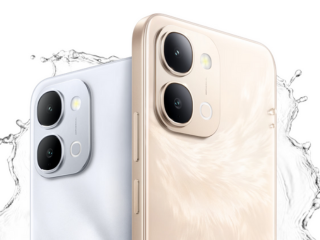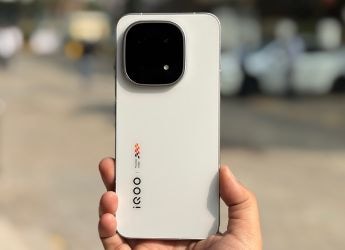- Home
- Mobiles
- Mobiles Features
- Motorola One Fusion+ vs Redmi Note 9 Pro Max: Best Phone Under Rs. 20,000?
Motorola One Fusion+ vs Redmi Note 9 Pro Max: Best Phone Under Rs. 20,000?
Should you pick the Motorola One Fusion+ or the Redmi Note 9 Pro Max?

The Motorola One Fusion+ costs Rs. 16,999 in India and the Redmi Note 9 Pro Max starts at the same price
The Motorola One Fusion+ has been a breath of fresh air in the budget Android category. This device checks most of my boxes for a good, affordable Android smartphone. It packs in a powerful processor and a big battery, and the cameras perform well for the price. The highlight for me has to be the near-stock Android experience, which has been missing from smartphones in the sub Rs. 20,000 price segment. While the Motorola One Fusion+ is a convincing package, is it better than the Redmi Note 9 Pro Max, which has been a popular choice since its launch? Can the Motorola One Fusion+ become the new go-to smartphone for those on a budget? I compare these two smartphones to see which is the best one for you.
Motorola One Fusion+ vs Redmi Note 9 Pro Max design: Hole punch or pop-up?
The Motorola One Fusion+ (Review) and the Redmi Note 9 Pro Max (Review) take different approaches to design. Xiaomi has gone with a hole-punch display for the Redmi Note 9 Pro Max, and this is now common on devices at all price levels. This allows the selfie camera to peep through a hole in the display panel. Motorola has gone with a pop-up selfie camera module which rises above the screen when required.
A few other brands have tried pop-up modules in the past, but this trend is now declining. The advantage is that the display does not have a cutout or hole that obstructs content. If you watch videos on your smartphone very often, the One Fusion+ offers you an uninterrupted view. However, there's a slight delay due to the mechanism and the front camera isn't available immediately when you need it.
The Redmi Note 9 Pro Max has a bigger screen which is convenient to watch videos on, but isn't ideal for single-handed use. I found the Motorola One Fusion+ to be slightly better in this respect but it still needs a tiny shuffle in the hand to reach the top of the display. Also, the bottom-firing speaker on the Motorola is louder than the one on the Redmi, which takes the viewing experience up a notch.
![]()
Redmi Note 9 Pro Max (right) has a slightly bigger display than the Motorola One Fusion+ (left)
The Redmi Note 9 Pro Max has a side-mounted fingerprint scanner while the Motorola One Fusion+ has a one on the back. I prefer the rear-mounted scanner since that is where either index finger rests naturally, making it easy to quickly unlock the phone. Button placement is slightly better on the Motorola One Fusion+ as these are easier to reach than the ones on the Redmi Note 9 Pro Max.
Motorola and Xiaomi have both opted for quad-camera setups but the designs are different. The module on the Redmi Note 9 Pro Max juts out quite a bit, causing the device to rock when placed on a flat surface. The back panel of the Redmi Note 9 Pro Max is made of Corning Gorilla Glass 5, which gives it a premium look and feel. The Motorola One Fusion+ on the other hand is made out of plastic.
Both smartphones have a USB Type-C port, speaker, and 3.5mm headphone jack at the bottom. The Redmi Note 9 Pro Max has an IR emitter on the top, which can be used to control appliances. Both smartphones have roughly the same battery capacity but the One Fusion+ is the chunkier of the two. In terms of charging, Redmi Note 9 Pro Max has a clear lead with its faster 33W charging, while the One Fusion+ has to do with an 18W charger.
Motorola One Fusion+ vs Redmi Note 9 Pro Max specifications and software: User experience matters
The Motorola One Fusion+ sports a 6.5-inch HDR10 certified full-HD+ IPS display while the Redmi Note 9 Pro Max has a 6.67-inch full-HD+ display that is said to be able to reproduce 84 percent of the NTSC colour gamut. Motorola does not offer any sort of protection for the panel, while Xiaomi has used Corning Gorilla Glass 5.
Motorola has picked the Qualcomm Snapdragon 730G for the One Fusion+ in India, while international markets get the Snapdragon 730 SoC. Surprisingly, the One Fusion+ is available in one configuration only, with 6GB of RAM and 128GB of storage, priced at Rs. 16,999.
![]()
The Motorola One Fusion+ (left) has a pop-up selfie camera
Xiaomi on the other hand picked the Snapdragon 720G to power the Redmi Note 9 Pro Max, and offers it in three variants: 6GB of RAM with 64GB of storage priced at Rs. 16,999; 6GB of RAM with 128GB of storage for Rs. 18,499; and 8GB of RAM with 128GB of storage for Rs. 19,999. The Redmi Note 9 Pro Max was launched at lower prices, but a GST hike and another recent adjustment have made it more expensive.
While both devices support dual SIMs with 4G and VoLTE, only the Redmi Note 9 Pro Max has a dedicated microSD card slot. With the Motorola One Fusion+, you will have to choose between a second SIM and storage expansion because of its hybrid dual-SIM slot. Both phones support Bluetooth 5, dual-band Wi-Fi, and multiple navigation systems.
Both these smartphones run Android 10 and had the April security patch at the time of our comparison, but the user interfaces are very different. The Redmi Note 9 Pro Max runs the heavily modified MIUI 11 skin on top of Android. It also comes with a fair amount of preinstalled bloatware, and I found a few apps including Xiaomi's stock ones showing unwanted ads and notifications when I reviewed the smartphone. The Motorola One Fusion+ is much closer to stock Android and it does not have a lot of preinstalled bloatware. I did not encounter a single spammy notification during the review period, and preferred the clean user interface of the Motorola One Fusion+ over the Redmi Note 9 Pro Max.
Motorola One Fusion+ vs Redmi Note 9 Pro Max performance: The leveller
I found both these smartphones to be fast, and at no time did either one lag or stutter. Both the tested units had 6GB of RAM and 128GB of storage, so I was curious to see which one would come out on top in terms of performance. Both phones are quick to unlock when using their fingerprint scanners, and the Redmi Note 9 Pro Max is also capable of face recognition, which the Motorola One Fusion+ lacks.
I watched a couple of videos on both these devices and found the Motorola One Fusion+ to have a slightly better screen as well as speaker, giving it a lead over the Redmi Note 9 Pro Max. I ran a couple of benchmarks on both these devices and the results were quite similar. In Antutu, the Motorola One Fusion+ managed to score 273,407 while the Redmi Note 9 Pro Max managed 277,058. In Geekbench 5's single- and multi-core tests, the Motorola One Fusion+ managed 548 and 1,691 points respectively while the Redmi Note 9 Pro Max scored 564 and 1,759. As for graphics benchmarks, GFXBench's T-Rex and Car Chase scenes ran at 55fps and 15fps respectively on the One Fusion+, while the Redmi Note 9 Pro Max managed 59fps and 16fps respectively.
![]()
The button placement on the Motorola One Fusion+ (bottom) is better
I played PUBG Mobile on both these smartphones, and they defaulted to the High preset. Both were capable of playing the game without any issues, but I did notice that the Redmi Note 9 Pro Max got warm to the touch after playing for 20 minutes while the Motorola One Fusion+ was barely affectedafter the same duration.
Both test phones deliver roughly the same battery life, lasting for about a day and a half on a full charge with regular usage. However, in our HD video loop test, the Redmi Note 9 Pro Max managed a better score at 17 hours and 10 minutes compared to the 15 hours, 45 minutes that the Motorola One Fusion+ lasted. Charging is quicker for the Redmi Note 9 Pro Max since it has a 33W charger, and it can get up to 90 percent in an hour. The slower 18W charger that comes with the One Fusion+ could only get it up to 60 percent in the same time.
Motorola One Fusion+ vs Redmi Note 9 Pro Max cameras: Surprising outcomes
The Motorola One Fusion+ and the Redmi Note 9 Pro Max both have four cameras at the back. The camera configuration is identical on both these devices: a 64-megapixel primary sensor, an 8-megapixel ultra-wide-angle camera, a 5-megapixel macro camera, and a 2-megapixel depth sensor. Both phones take 16-megapixel photos by default. The selfie cameras are a little different though – the Redmi Note 9 Pro Max sports a 32-megapixel selfie shooter compared to the 16-megapixel one on the Motorola One Fusion+.
![]()
Both these smartphones sport quad-camera setups
I found the two manufacturers' camera apps to be simple and straightforward. These apps have different modes to choose from but I stuck to the basics for this comparison. Both phones are quick to lock focus and meter a scene. In daylight, both phones enabled HDR to shoot a bright scene, but it was the Redmi Note 9 Pro Max that managed a better shot, whereas the Motorola One Fusion+ overexposed the sky. On zooming in to the photo, it was the One Fusion+ that captured sharper, better details. Switching to the wide-angle camera allows either phone to capture a wider field of view. The Motorola One Fusion+ managed to get the exposure right, but it was the Redmi Note 9 Pro Max that delivered better quality overall.
Motorola One Fusion+ and Redmi Note 9 Pro Max daylight camera samples (tap to see larger image)
Motorola One Fusion+ and Redmi Note 9 Pro Max wide-angle camera samples (tap to see larger image)
For closeups, the Motorola One Fusion+ was the clear winner. It got the colour tone right, while the Redmi Note 9 Pro Max's shot had a yellowish tone. Both phones managed good depth of field.
Motorola One Fusion+ and Redmi Note 9 Pro Max close-up camera samples (tap to see larger image)
Both phones did a good job with portraits, and you can set the level of blur before taking a shot. I found both to be on par for portraits, as they managed good edge detection and blurred out the background properly.
Motorola One Fusion+ and Redmi Note 9 Pro Max portrait camera samples (tap to see larger image)
The macro cameras on both these smartphones have 5-megapixel sensors, and let you get very close to a subject while shooting. I found the Motorola One Fusion+ camera to produce better macro shots.
Motorola One Fusion+ and Redmi Note 9 Pro Max macro camera samples (tap to see larger image)
Both these smartphones manage to keep noise under control in photos taken in low light. The Redmi Note 9 Pro Max gave us slightly brighter shots and better details than the Motorola One Fusion+. With Night mode enabled, both smartphones keep their camera shutters open for longer, which results in brighter images. The Redmi Note 9 Pro Max manages to capture better details in the shadows. However, the shots we took had a weird red hue. When we zoomed in, the Motorola One Fusion+'s shots looked better.
Motorola One Fusion+ and Redmi Note 9 Pro Max low-light camera samples (tap to see larger image)
Motorola One Fusion+ and Redmi Note 9 Pro Max night mode camera samples (tap to see larger image)
Both phones fail to capture good close-ups in low light, but the AI on the Redmi Note 9 Pro Max boosted colours which made objects look odd.
Motorola One Fusion+ and Redmi Note 9 Pro Max low-light close-up camera samples (tap to see larrger image)
For selfies, in both daylight as well as low light, the Motorola One Fusion+ did better than the Redmi Note 9 Pro Max.
Motorola One Fusion+ and Redmi Note 9 Pro Max daylight selfie camera samples (tap to see larger image)
Motorola One Fusion+ and Redmi Note 9 Pro Max low-light selfie camera samples (tap to see larger image)
Video recording maxes out at 4K for both these smartphones, and both use EIS to stabilise footage. In daylight, while shooting at 1080p, the Redmi Note 9 Pro Max managed better stabilisation. The Motorola One Fusion+ oversharpened footage in comparison, and stabilisation wasn't as good. For 4K video, it was the Motorola One Fusion+ that came out on top. In low light, the Redmi Note 9 Pro Max managed to record brighter video compared to the Motorola One Fusion+, but there was shimmer in both phone's recordings.
Verdict
After comparing these two smartphones I can say that picking a clear winner isn't as easy as I thought it would be. The Redmi Note 9 Pro Max has a newer design, and Corning Gorilla Glass 5 at the front and the back. On the other hand the Motorola One Fusion+ has a pop-up selfie camera and an all-screen front without any distractions, as well as a louder speaker to go with it. The hardware is also evenly matched, as there isn't a huge difference between the performance of the Snapdragon 730G and Snapdragon 720G SoCs. Both smartphones deliver roughly the same battery life as well, though the Redmi Note 9 Pro Max can be charged quicker.
The cameras are also pretty neck-and-neck across these smartphones, and both have scope for improvements via updates. Coming to software, for me, the Motorola One Fusion+ is the clear winner with its clean stock Android. It also doesn't bombard you with push notifications.
What makes this more interesting is that Motorola has managed to undercut Xiaomi when it comes to pricing. The Motorola One Fusion+ (Review) is priced at Rs. 16,999, which is also the starting price for the Redmi Note 9 Pro Max (Review) with less storage. The same configuration will set you back by Rs. 18,499. You could also choose the Redmi Note 9 Pro (Review), which is priced at Rs. 16,999 for 6GB of RAM and 128GB of storage, but you'll lose out on the 33W fast charging and get slightly less impressive front and rear cameras. This could very well be the deciding factor for a lot of people between the two.
Is Redmi Note 9 Pro Max the best affordable camera phone in India? We discussed this on Orbital, our weekly technology podcast, which you can subscribe to via Apple Podcasts or RSS, download the episode, or just hit the play button below.
Catch the latest from the Consumer Electronics Show on Gadgets 360, at our CES 2026 hub.
Related Stories
- Samsung Galaxy Unpacked 2025
- ChatGPT
- Redmi Note 14 Pro+
- iPhone 16
- Apple Vision Pro
- Oneplus 12
- OnePlus Nord CE 3 Lite 5G
- iPhone 13
- Xiaomi 14 Pro
- Oppo Find N3
- Tecno Spark Go (2023)
- Realme V30
- Best Phones Under 25000
- Samsung Galaxy S24 Series
- Cryptocurrency
- iQoo 12
- Samsung Galaxy S24 Ultra
- Giottus
- Samsung Galaxy Z Flip 5
- Apple 'Scary Fast'
- Housefull 5
- GoPro Hero 12 Black Review
- Invincible Season 2
- JioGlass
- HD Ready TV
- Laptop Under 50000
- Smartwatch Under 10000
- Latest Mobile Phones
- Compare Phones
- OnePlus Turbo 6V
- OnePlus Turbo 6
- Itel Zeno 20 Max
- OPPO Reno 15 Pro Mini 5G
- Poco M8 Pro 5G
- Motorola Signature
- Vivo Y50e 5G
- Vivo Y50s 5G
- Lenovo Yoga Slim 7x (2025)
- Lenovo Yoga Slim 7a
- Realme Pad 3
- OPPO Pad Air 5
- Xiaomi Watch 5
- Huawei Watch 10th Anniversary Edition
- Acerpure Nitro Z Series 100-inch QLED TV
- Samsung 43 Inch LED Ultra HD (4K) Smart TV (UA43UE81AFULXL)
- Asus ROG Ally
- Nintendo Switch Lite
- Haier 1.6 Ton 5 Star Inverter Split AC (HSU19G-MZAID5BN-INV)
- Haier 1.6 Ton 5 Star Inverter Split AC (HSU19G-MZAIM5BN-INV)

















